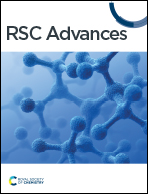Development of radical initiator based on o-imino-isourea capable of photo/thermal polymerization †
Abstract
Using o-imino isourea, three photo- and thermal dual-responsive radical initiators dicyheDCC, CyheDCC, and BnDCC were systematically developed and synthesized. By adding an aromatic ring to the free radical initiators, the ultraviolet-visible absorption was redshifted, and the absorption coefficient was increased. Compared with other initiators, BnphDCC exhibited an exceptional photoinitiation rate under photo-differential scanning calorimetry (DSC) and a high absorption coefficient (ε = 15 420 M−1 cm−1). Therefore, it is an appropriate potential photoinitiator. DicyheDCC, which was composed of a cyclic hydrocarbon, exhibited rapid thermal initiation (Tpeak = 82 °C) during thermal DSC, making it a valuable thermal radical initiator. Because of the low stiffness of the N–O link in radical initiators, density functional theory predicts that the aliphatic ring has a significantly lower enthalpy than the aromatic ring. Moreover, in this study, CyhephDCC and BnphDCC, as dual-responsive radical initiators, indicated the potential for a photo- and heat dual-curing system through the universal free-radical polymerization of acrylates. These significant discoveries may be useful for developing efficient and diversified polymer network systems that require synergistic photo- and thermal effects.



 Please wait while we load your content...
Please wait while we load your content...